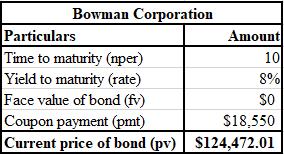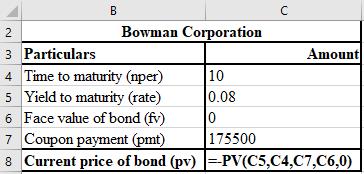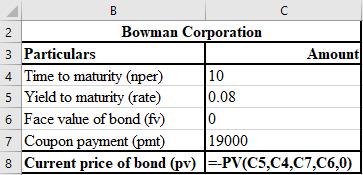
Concept explainers
a.
To calculate: The PV of total outflows of The Bowman Corporation.
Introduction:
Present value (PV):
The current value of an investment or an asset is termed as its present value. It is evaluated by discounting the
a.
Answer to Problem 17P
The PV of total outflow of The Bowman Corporation is $1,458,528.
Explanation of Solution
Calculation of PV of outflows:
Working Notes:
Calculation of payment of call premium:
Calculation of tax saving per year:
The calculation of current price of bond, that is, PV of future tax savings is shown below.

The formula used for the calculation of current price of bond, that is, PV of future tax savings is shown below.

Calculation of underwriting cost of new issue:
b.
To calculate: The PV of the total inflow of The Bowman Corporation.
Introduction:
Present value (PV):
The current value of an investment or an asset is termed as its present value. It is evaluated by discounting the future value of the investment or asset.Â
b.
Answer to Problem 17P
The PV of the total inflow of Bowman Corporation is $1,199,484.
Explanation of Solution
Calculation of PV of inflows:
Working Notes:
The calculation of PV of future tax savings is shown below.

The formula used for the calculation of PV of future tax savings is shown below.

The calculation of PV of deferred future write off is shown below.

The formula used for the calculation of PV of deferred future write off is shown below.

Calculation of gain in old underwriting cost write-off:
Calculation of Underwriting cost write-off:
c.
To calculate: The NPV of The Bowman Corporation.
Introduction:
A project’s NPV profile is the representation done graphically of the project’s NPV corresponding to different values of the rate of discount. It shows the changes that take place in NPV as a result of the changes in the cost of capital.
c.
Answer to Problem 17P
The NPV of The Bowman Corporation is ($259,045).
Explanation of Solution
Calculation of NPV:
d.
To determine: Whether the old issue shall be refunded with The Bowman Corporation’s new debt.
Introduction:
Present value (PV):
The current value of an investment or an asset is termed as its present value. It is evaluated by discounting the future value of the investment or asset.Â
d.
Answer to Problem 17P
No, the old issue of The Bowman Corporation shall not be refunded.
Explanation of Solution
The Bowman’s Corporation’s old issue shall not be refunded, especially if there exists a chance that the rate of interest will further go down, as the NPV calculated in part (c) is negative.
Want to see more full solutions like this?
Chapter 16 Solutions
Loose Leaf for Foundations of Financial Management Format: Loose-leaf
- On April 1, 20-1, Rebound Co. issued $300,000 of 10%, 10-year bonds, callable at 105 after three years, at face value. On April 1, 20-4, after completing three years of interest payments on the bonds, Rebound is considering calling the bonds and issuing $300,000 of new 8%, 10-year bonds at face value. The current market interest rate is only 8%, so Rebound thinks it might save money by taking this action.arrow_forwardIf a company issues $100,000 Face Value, 10 year bonds with a contractural interest rate of 6%, which of the following situations could occur?a. Bonds will be sold at a premium when the market rate of interest is 7%b. Bonds will be sold at a discount when market rate is of interest 7%c. Bonds will be sold at face value when market rate of interest is 7%d. The issue of bonds cannot be sold when market rate is 7%arrow_forwardOn January 1, 2020, West-Tex Oil issued $50 million of 8% bonds maturing in 10 years. The market interest rate on the issue date was 9%, which resulted in the bonds being issued at a discount. In December 2021, Tex Winters, the company CFO, notes that in the two years since the bonds were issued, interest rates have fallen almost 3%. Tex suggests that West-Tex might consider repurchasing the 8% bonds and reissuing new bonds at the lower current interest rates. Another executive, Will Bright, asks, “Won’t the repurchase result in a large loss to our financial statements?” Tex agrees, indicating that West-Tex is likely to just meet earnings targets for 2021. The company would probably not meet its targets with a multimillion-dollar loss on a bond repurchase. However, 2022 looks to be a record-breaking year. They decide that maybe they should wait until 2022 to repurchase the bonds. How could the repurchase of debt cause a loss to be reported in net income? Explain how the repurchase of…arrow_forward
- Janutis Co. has just issued fixed rate debt at 10 percent. Yet it prefers to convert its financing to incur a floating rate on its debt. It engages in an interest rate swap in which it swaps variable rate payments of LIBOR plus 1 percent inexchange for payments of 10 percent. The interest rates are applied to an amount that represents the principal from its recent debt issue in order to determine the interest payments due at the end of each year for the next three years. Janutis Co. expects that the LIBOR will be 9 percent at the end of the first year, 8.5 percent at the end of the second year, and 7 percent at the endof the third year. Determine the financing rate that Janutis Co. expects to pay on its debt after considering the effect of the interest rate swap.arrow_forwardSeveral years ago, the Jakobe Company issued a $1,000 par value, non-callable bond that now has 20 years to maturity and a 1% annual coupon that is paid semiannually. The bond currently sells for $945, and the companys tax rate is 40%. What is the component after-tax cost of debt for use in the WACC calculation? Your answer should be between 3.34 and 5.43, rounded to 2 decimal places, with no special characters.arrow_forwardABC company will contract a new loan in the sum of $2,000,000 that is secured by machinery and the loan has an interest rate of 6 percent. The company has also issued 4,000 new bond issues with an 8 percent coupon, paid semi-annually, and matures in 10 years. The bonds were sold at par and incurred a floatation cost of 2 percent per issue. 1. Does the New loan have anything to do with calculating the cost of debt? 2. Should the new loan be considered in the calculation of the weighted average cost of capital (WACC) of the company? if so how should it be added to the WACC formula.arrow_forward
- Colson Inc. issues 10-year bonds with a maturity value of $300,000. If the bonds are issued at a discount, this indicates that: Question 15 options: the contractual interest rate exceeds the market interest rate. the market interest rate exceeds the contractual interest rate. the contractual interest rate and the market interest rate are the same. no relationship exists between the two rates.arrow_forwardSunland Railroad Co. is about to issue $298,000 of 10-year bonds paying an 12% interest rate, with interest payable annually. The discount rate for such securities is 8%. How much can sunland expect to receive for the sale of these bonds? ????Present value of bonds ????arrow_forwardSMC will be issuing bonds with a face value of P100,000 through an underwriter. The underwriter will be issuing the bonds at 106 but will charge 7% on face amount. The bonds will be irredeemable and will pay 8% annually. If the tax rate is 25%, what is the effective cost of the bonds?arrow_forward
- OShea Inc. issued bonds at a face value of $100,000, a rate of 6%, and a 5-year term for $98,000. From this information, we know that the market rate of interest was ________. A. more than 6% B. less than 6% C. equal to 6% D. cannot be determined from the information given.arrow_forwardOn January 1, 2018, Wawatosa Inc. issued 5-year bonds with a face value of $200,000 and a stated interest rate of 12% payable semi-annually on July 1 and January 1. The bonds were sold to yield 10%. Assuming the bonds were sold at 107.732, what is the selling price of the bonds? Were they issued at a discount or a premium?arrow_forwardOn July 1, Somerset Inc. issued $200,000 of 10%, 10-year bonds when the market rate was 12%. The bonds paid interest semi-annually. Assuming the bonds sold at 58.55, what was the selling price of the bonds? Explain why the cash received from selling this bond is different from the $200,000 face value of the bond.arrow_forward
 EBK CONTEMPORARY FINANCIAL MANAGEMENTFinanceISBN:9781337514835Author:MOYERPublisher:CENGAGE LEARNING - CONSIGNMENT
EBK CONTEMPORARY FINANCIAL MANAGEMENTFinanceISBN:9781337514835Author:MOYERPublisher:CENGAGE LEARNING - CONSIGNMENT Cornerstones of Financial AccountingAccountingISBN:9781337690881Author:Jay Rich, Jeff JonesPublisher:Cengage LearningPrinciples of Accounting Volume 1AccountingISBN:9781947172685Author:OpenStaxPublisher:OpenStax College
Cornerstones of Financial AccountingAccountingISBN:9781337690881Author:Jay Rich, Jeff JonesPublisher:Cengage LearningPrinciples of Accounting Volume 1AccountingISBN:9781947172685Author:OpenStaxPublisher:OpenStax College


